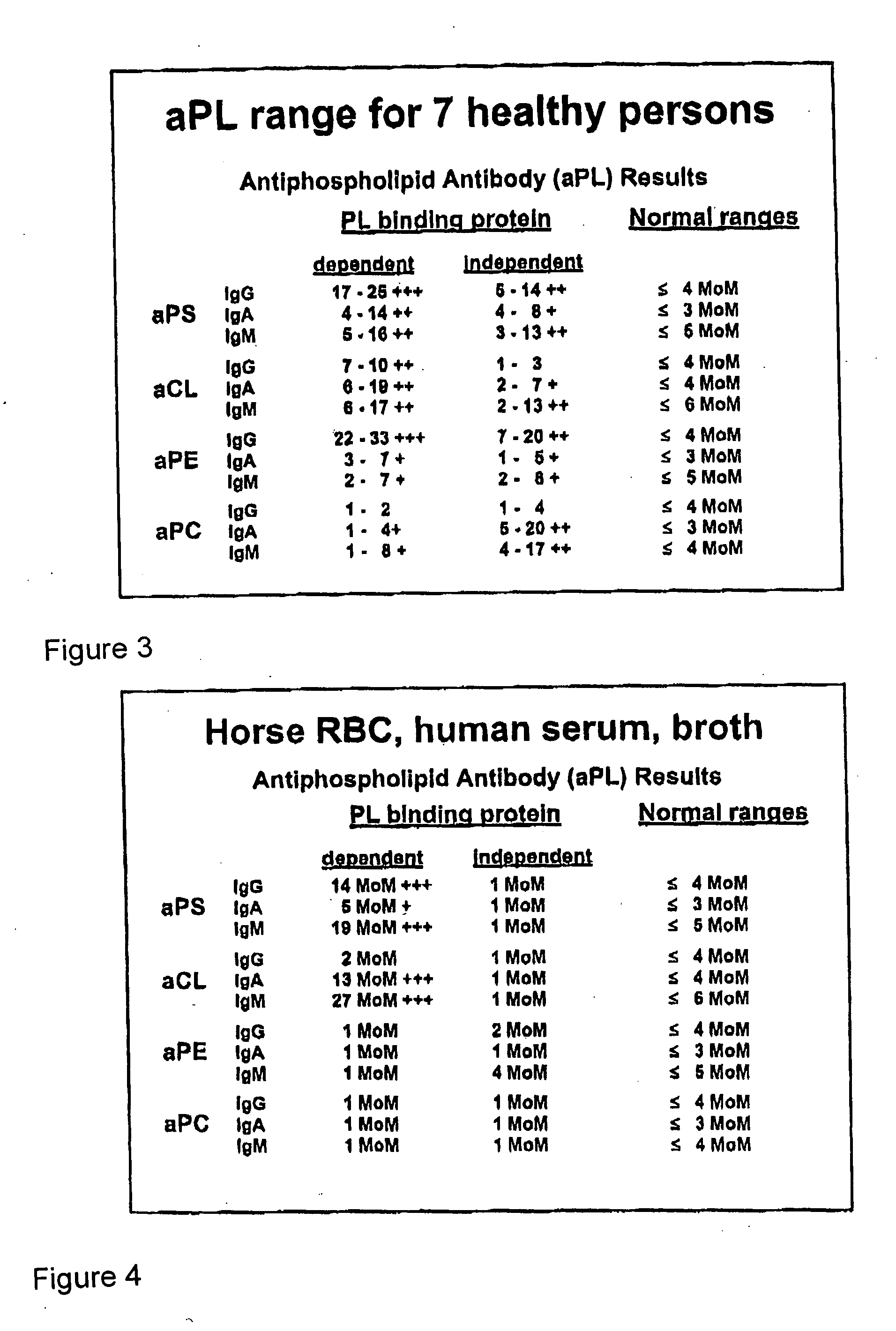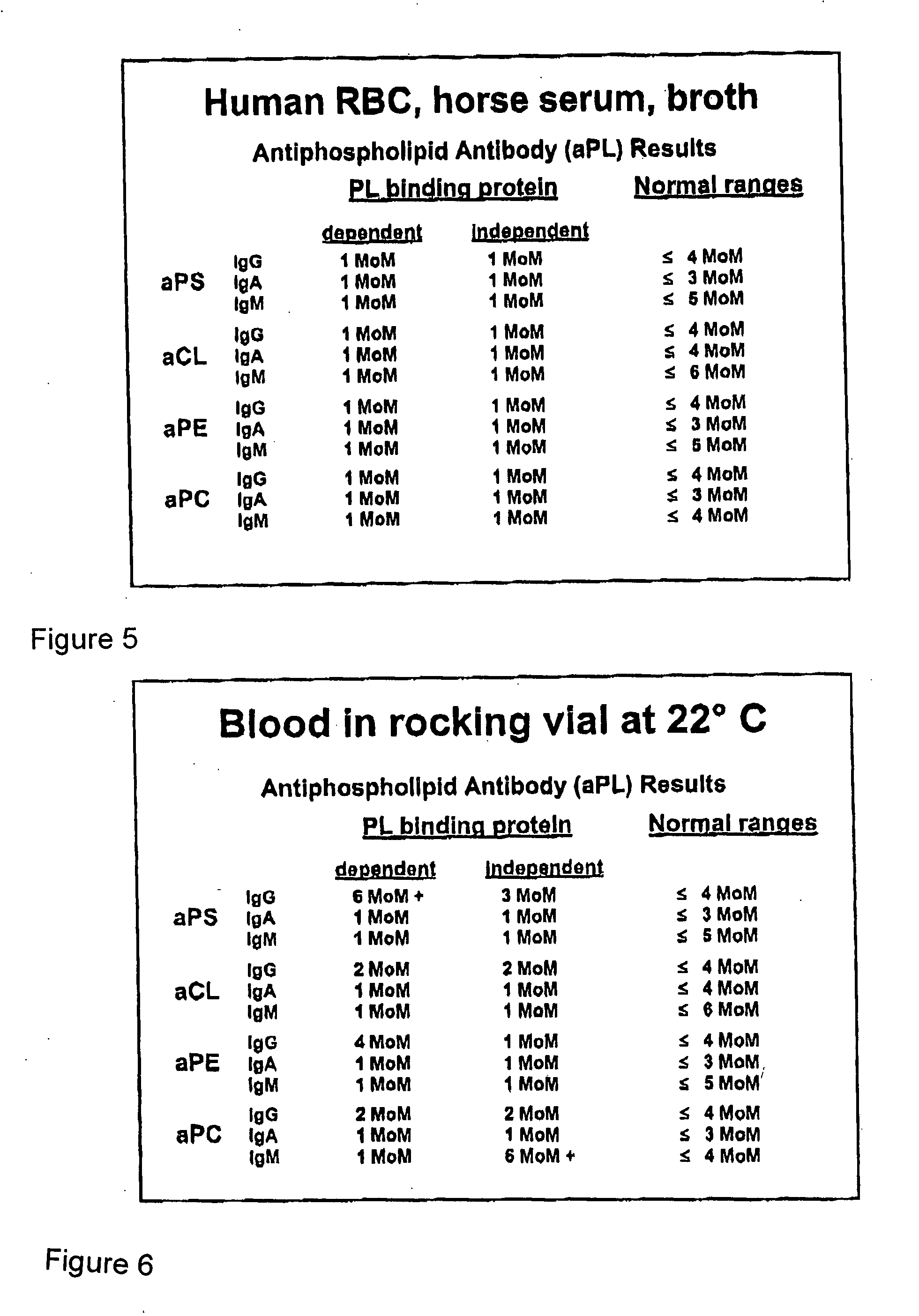Method of altering the binding specificity of plasma proteins by oxidation-reduction reactions
a technology of oxidation reduction reaction and plasma protein, which is applied in the field of altering the binding specificity of plasma proteins by oxidation reduction reaction, can solve the problems of difficult collection of large amounts of autoantibodies for commercial use, limited amount of such blood that can be obtained from phlebotomy of individual patients or pooling blood from a group of patients known to test positive for autoantibodies, and other methods such as screening phage libraries, which are described in u.s
- Summary
- Abstract
- Description
- Claims
- Application Information
AI Technical Summary
Benefits of technology
Problems solved by technology
Method used
Image
Examples
example 1
[0078] A sample of blood from a normal subject was incubated and tested according to the procedure described above. The results of the aPL ELISA are shown in FIG. 2. As shown in FIG. 2, the incubated blood sample shows a dramatic presence of autoantibody activity, in comparison to the normal, untreated blood shown in the Normal ranges column. In particular, strong autoantibody activity is shown in the protein-dependent category for aPS (IgG), aCL (all isotypes), and aPE (IgG). The low or absent IgG aPC autoantibody activity was a characteristic finding in the early examples and in procedures in which hemin was used as the oxidizing agent. This result indicates that autoantibodies to PC, especially of the IgG isotype are different and perhaps do not become activated in the same way as do the others. In later experiments, it was found that significant levels of aPC can be detected in samples that were treated with KMnO4 (data not shown).
example 2
[0079] Blood samples drawn from seven healthy subjects were incubated and tested according to the procedure described above. In particular, all seven subjects' bloods were drawn within a 20 minute period and incubated for 20 hours in identical conditions. FIG. 3 is a composite table showing the range of aPL seroconversion for these seven samples. These results show that there are variations in the aPL levels detected as well as the isotypes present among different individuals. Nevertheless, as shown by the invention, each individual had aPL antibodies that could be detected after incubation.
example 3
[0080] In a first experiment, a serum sample from a normal subject was incubated and tested according to the basic procedure described above. In the incubation mixture, horse red blood cells (RBC) were used instead of human RBC. The results of the aPL ELISA are shown in FIG. 4. As shown in FIG. 4, significant aPL activity was obtained, particularly with respect to aPS (IgG and IgM) and aCL (IgA and IgM).
[0081] In a second experiment, a horse serum, instead of human serum, was incubated with human RBC and tested according to the basic procedure described above. The results of the aPL ELISA are shown in FIG. 5. As shown in FIG. 5, aPL activity was not obtained. (The ELISA assay used in this experiment utilized human-antibody-specific alkaline phosphatase labeled antibody probes to detect aPL, so whether the incubated sample contained horse aPL is unknown.) The results shown summarized in FIGS. 4 and 5 unequivocally demonstrate that all aPL that are obtained during the seroconversion ...
PUM
| Property | Measurement | Unit |
|---|---|---|
| temperature | aaaaa | aaaaa |
| electric potential | aaaaa | aaaaa |
| total volume | aaaaa | aaaaa |
Abstract
Description
Claims
Application Information
 Login to View More
Login to View More - R&D
- Intellectual Property
- Life Sciences
- Materials
- Tech Scout
- Unparalleled Data Quality
- Higher Quality Content
- 60% Fewer Hallucinations
Browse by: Latest US Patents, China's latest patents, Technical Efficacy Thesaurus, Application Domain, Technology Topic, Popular Technical Reports.
© 2025 PatSnap. All rights reserved.Legal|Privacy policy|Modern Slavery Act Transparency Statement|Sitemap|About US| Contact US: help@patsnap.com



